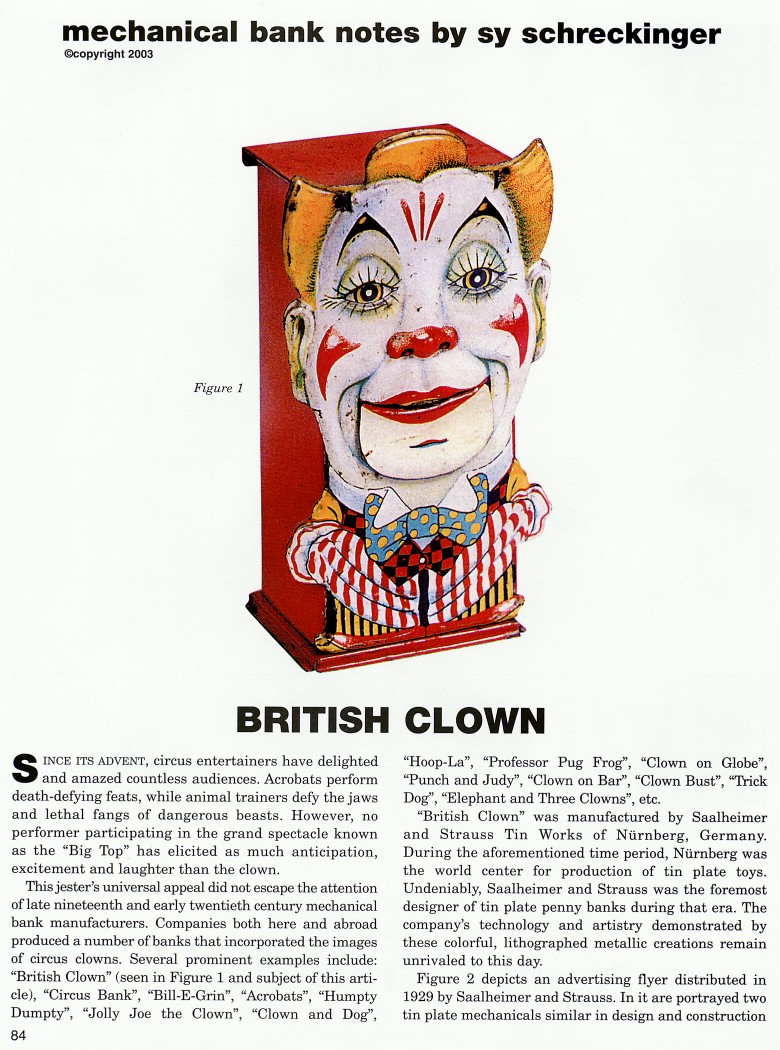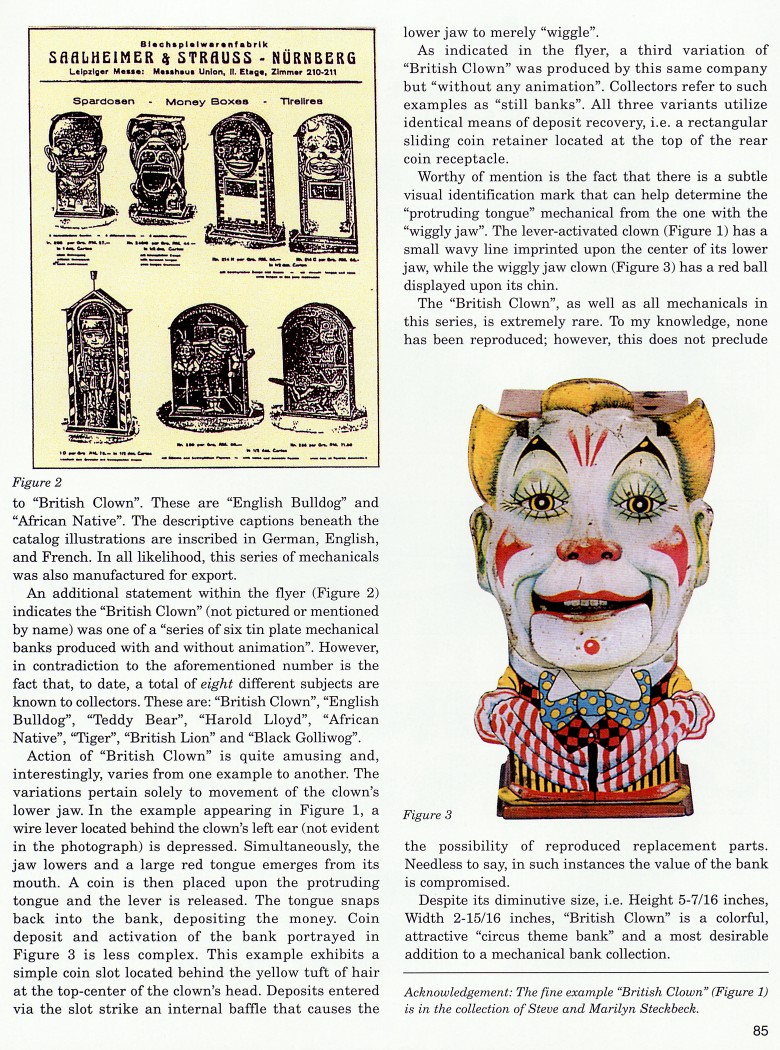|
British Clown
by Sy Schreckinger – ANTIQUE TOY WORLD Magazine – March, 2003
Since its advent, circus entertainers have
delighted and amazed countless audiences. Acrobats perform death-defying
feats, while animal trainers defy the jaws and lethal fangs of dangerous
beasts. However, no performer participating in the grand spectacle known
as the "Big Top" has elicited as much anticipation, excitement and
laughter than the clown.
This jester's universal appeal did not escape the attention of late
nineteenth and early twentieth century mechanical bank manufacturers.
Companies both here and abroad produced a number of banks that
incorporated the images of circus clowns. Several prominent examples
include: "British Clown" (seen in Figure 1 and subject of this article),
"Circus Bank", "Bill-E-Grin", "Acrobats", "Humpty Dumpty", "Jolly Joe the
Clown", "Clown and Dog", "Hoop-La", "Professor Pug Frog", "Clown on
Globe", "Punch and Judy", "Clown on Bar", "Clown Bust", "Trick Dog",
"Elephant and Three Clowns", etc.
"British Clown" was manufactured by Saalheimer and Strauss Tin Works
of Nurnberg, Germany. During the aforementioned time period, Nurnberg was
the world center for production of tin plate toys. Undeniably, Saalheimer
and Strauss was the foremost designer of tin plate penny banks during that
era. The company's technology and artistry demonstrated by these colorful,
lithographed metallic creations remain unrivaled to this day.
Figure 2 depicts an advertising flyer distributed in 1929 by
Saalheimer and Strauss. In it are portrayed two tin plate mechanicals
similar in design and construction to "British Clown". These are "English
Bulldog" and "African Native". The descriptive captions beneath the
catalog illustrations are inscribed in German, English, and French. In all
likelihood, this series of mechanicals was also manufactured for export.
An additional statement within the flyer (Figure 2) indicates the
"British Clown" (not pictured or mentioned by name) was one of a "series
of six tin plate mechanical banks produced with and without animation".
However, in contradiction to the aforementioned number is the fact that,
to date, a total of eight different subjects are known to collectors.
These are: "British Clown", "English Bulldog", "Teddy Bear", "Harold
Lloyd", "African Native", "Tiger", "British Lion" and "Black Golliwog".
Action of "British Clown" is quite amusing and, interestingly, varies
from one example to another. The variations pertain solely to movement of
the clown's lower jaw. In the example appearing in Figure 1, a wire lever
located behind the clown's left ear (not evident in the photograph) is
depressed. Simultaneously, the jaw lowers and a large red tongue emerges
from its mouth. A coin is then placed upon the protruding tongue and the
lever is released. The tongue snaps back into the bank, depositing the
money. Coin deposit and activation of the bank portrayed in Figure 3 is
less complex. This example exhibits a simple coin slot located behind the
yellow tuft of hair at the top-center of the clown's head. Deposits
entered via the slot strike an internal baffle that causes the the lower
jaw to merely "wiggle".
As indicated in the flyer, a third variation of "British Clown" was
produced by this same company but "without any animation". Collectors
refer to such examples as "still banks". All three variants utilize
identical means of deposit recovery, i.e. a rectangular sliding coin
retainer located at the top of the rear coin receptacle.
Worthy of mention is the fact that there is a subtle visual
identification mark that can help determine the "protruding tongue"
mechanical from the one with the "wiggly jaw". The lever-activated clown
(Figure 1) has a small wavy line imprinted upon the center of its lower
jaw, while the wiggly jaw clown (Figure 3) has a red ball displayed upon
its chin.
The "British Clown", as well as all mechanicals in this series, is
extremely rare. To my knowledge, none has been reproduced; however, this
does not preclude the possibility of reproduced replacement parts.
Needless to say, in such instances the value of the bank is compromised.
Despite its diminutive size, i.e. Height 5-7/16 inches, Width 2-15/16
inches, "British Clown" is a colorful, attractive "circus theme bank" and
a most desirable addition to a mechanical bank collection.
Acknowledgement: The fine example "British Clown" (Figure 1) is in
the collection of Steve and Marilyn Steckbeck.
|


